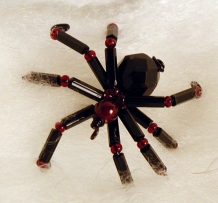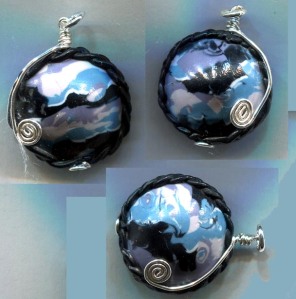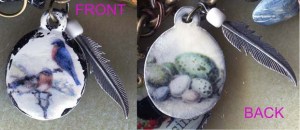This is a teaspoon that has the handle cut off and bent to be used as a pendant bail.
The first one I worked with was a larger tablespoon. I was going to drill holes in it for the wiring. However…it’s made of stainless steel, as is the teaspoon I used. Drill bits were burning up left and right. The oak wood scrap block I use to drill on has little woodburned dots all over it where the spoon rested. Even after switching to a cobalt drill bit and using 3-in-1 lubricating oil, the hole was almost through but couldn’t quite get it all the way. I was able to drill exactly 1 hole all the way thru so I went another direction.
The handle was heated with a heat gun and then bent with pliers. Then, I used a Dremel with a cutting wheel to remove the spoon handle, leaving enough to bend inward to create a loop. It had to be heated several times to get the bend all the way to the spoon back–stainless steel…
I used twisted gun metal bronze (basically a pretty brown) wire as the back grid. I wanted twice as many loops for the top of the tree as for the roots, so I bent the wire and created the “root” loop. Then made a loop in the other ends to fold over the top of the spoon. To create a more decorative and organized spoon back, I alternated one pair of wires with the other for a crisscross pattern. One wire that wasn’t doubled, so I could have an odd number of loops.
The tree itself is 28 ga. wire (same color), 3 strands for each of the bottom holes. Once the tree trunk and main branches were defined by twisting, I added aquamarine chip beads, looping the twisted wire through the top loops. Those twigs were twisted together and tucked behind the gemstone leaves.
The finished pendant is strung onto a leather cord. At some point, I will try drilling the holes again, but this time the Dremel goes into its drill press where I can use steady consistent pressure.















